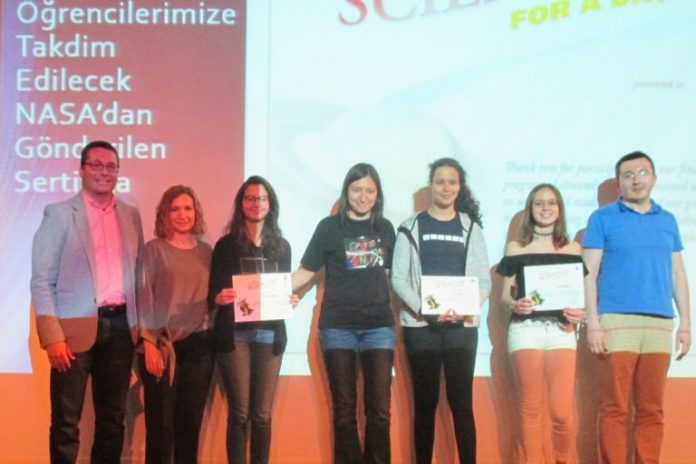Tepeören Yerleşkemizden lise öğrencimiz Ceren Köseoğlu (10 B), NASA’nın (National Aeronautics and Space Administration) düzenlediği “Bir Günlük Cassini Bilim İnsanı Makale Yarışması”na (Cassini Scientist For a Day Essay Contest) “Saturn’s Hexagon” başlıklı makalesiyle katıldı. Yarışmaya Fizik öğretmenimiz Burcu Güngör’ün danışmanlığında hazırlanan öğrencimizin makalesi, Türkiye elemesini geçerek NASA’ya gönderilmeye hak kazandı. Eyüboğlu Eğitim Kurumları’nın Türkiye temsilcisi olarak 2016 – 2017 öğretim yılında Türkiye’deki lise öğrencilerine yönelik organize ettiği yarışmada 12 makale seçildi. Bu makaleler http://solarsystem.nasa.gov adresinde yayımlanacak.
Yarışma; Satürn ve çevresini araştırmak üzere NASA tarafından gönderilen Cassini uzay aracının üç görevi, kaydettiği görüntüler ve elde ettiği bilgiler kullanılarak bir İngilizce makale yazma yarışmasıdır. Öğrencilerin bilimsel düşünme becerilerinin geliştirilmesi ve bu görüşlerini İngilizce olarak bir makalede toplamaları hedeflenmektedir. Bunun için Cassini uzay aracının çektiği 3 farklı görüntüyü öğrencilerin yorumlaması ve hangisinin bilimsel açıdan diğerlerine göre daha fazla önem taşıdığını kendi nedenleriyle aktarmaları istenmektedir.
Saturn’s Hexagon
In this enormous universe, that we are determined to learn about, there are unique and diverse planets. Space is full of mysteries that have been waiting to be solved. There are too many features on planets just like Enceladus’ Plumes, Titan’s Lakes and Saturn’s hexagon. However, my favorite target is the third target which is Saturn’s Hexagon. Because of the reason that any high speed hurricane with an eye just like the one on Saturn have not been seen, I think that this target will provide the most interesting and significant scientific result. There are many research objects such as; its shape, its time to began activity, duration and its color which may lead the project forward.
Firstly, as it was stated in the target’s video, “it is wide enough that two worlds can fit inside it with room to spare”. Which means it may be more dangerous due to the power and the speed it has. “Spanning about 20,000 miles (30,000 kilometers) across, the hexagon is a wavy jet stream of 200-mile-per-hour winds (about 322 kilometers per hour) with a massive, rotating storm at the center (1)”. As a consequence of this speed, in the future it may grow enough to create gravity force to other planets. Moreover, this may damage and slow down other projects related to Saturn. Apart from that, the shape which names this mysterious movement is also remarkable. There are other jet streams but none of them have been monitored as a shape of hexagon. One of the theories which clarifies this shape is fluid dynamics.
Secondly, the time it began is actually not accurate if it is considered that it was first monitored in 1980s. Activity duration is one of the most important and interesting issue in order to solve how jet stream was started and when it will disappear. “The hexagon is just a current of air, and weather features out there that share similarities to this are notoriously turbulent and unstable. A hurricane on Earth typically lasts a week, but this has been here for decades — and who knows — maybe centuries (2)” says Andrew Ingersoll, Cassini Imaging Team.
Other research subject is definitely its color. Since it was first seen, a color change has distinguished between the years of 2012-2016. Once the color was noticed as bluish. However, currently, a color change of blue to golden has been identified. “The color change is thought to be an effect of Saturn’s seasons (3).” This change is prospective when how it may be affective on other movements. In order to discover the reason of why it is colored with blue or golden, further researches must be done.
“There is a massive hurricane tightly centered on the North Pole, with an eye about 50 times larger than the average hurricane eye on Earth (4)”. This unique six-sided jet stream at Saturn’s North Pole seems to provide the most interesting and unique scientific result by finding why it is shaped as a hexagon, how long it will be active, when did it begin and what is the cause of the color change. Hope to be witnesses to new discoveries…
BIBLIOGRAPHY
- NASA’s Cassini Spacecraft Obtains Best Views of Saturn Hexagon. (2017, February 31). https://saturn.jpl.nasa.gov/news/2509/nasas-cassini-spacecraft-obtains-best-views-of-saturn-hexagon/
- Saturn’s Hexagon in Motion. (2017, February 31). https://saturn.jpl.nasa.gov/science/saturn/hexagon-in-motion/
- Changing Colors in Saturn’s North. (2017, February 31). https://saturn.jpl.nasa.gov/resources/7539/
- Saturn’s Hexagon in Motion. (2017, February 31). https://saturn.jpl.nasa.gov/science/saturn/hexagon-in-motion/
Ceren Köseoğlu (10 B)
Terakki Vakfı
Özel Şişli Terakki Tepeören Lisesi

















